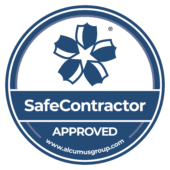Render is a great and popular way to change the appearance of a home. With unique coloured render options and a huge range of different textures, there's no end of different styles it can provide your home with. But to make sure that your render lasts as long as it should, you need to make sure you're regularly doing some sort of render cleaning. With the help of render cleaning services in Irthlingborough, you can keep your property looking incredible with EMS Powerwash.
No hassle, no obligation—just a fair price for top-quality cleaning.

There are a number of different ways to clean render. Some of them are more suited to specific render surfaces, and some are best suited to tasks like removing green algae and organic growth. Depending on which method you pick depends on whether it is manageable alone as a DIY task or whether it requires specialist skill and equipment.
Soft washing render uses a detergent and low-pressure washing with a brush. It is designed to be a soft and gentle cleaning process that avoids spraying chemicals that may then drift in the wind. It chemically cleans render and is considered more eco-friendly than other options because it uses less water. It can be done with pH-neutral products to help protect the colour and surface of the render.
Soft washing render is great if you need to remove green algae growth or remove stains from atmospheric pollution.
The process does require specialist equipment and knowledge. For example, you'd need:
Without these, you would not be able to softwash the surfaces effectively.
For small areas of dirt or small walls, it is possible to simply hand clean the render. This involves cleaning off loose dirt with a brush or your hand. You can then use a stiff brush or a hose to wipe down the render. Rinse it with clean water, and then, if needed, use a sponge to wipe away any remaining dirt on the vertical surfaces.
It is important to note that render cleaning with a pressure washer is dangerous. It is a cost-effective cleaning method, but it can often cause more harm than good. Rather than relying on cleaning chemicals, it uses high-pressure water streams to blast the mould spores and dirt off of the surface. It is particularly good at removing things like bird droppings from the walls.
However, this high-pressure water can damage the render surface during the render cleaning process. In turn, the damage can then lead to damp issues, further cracks and long-term problems, and could ultimately lead to needing to re-render the property.
Pressure washing render should only be done by professionals. Only experts should be using a power washer or pressure washer as a render cleaner, as they will know the right angle and pressure to use to complete render cleaning without causing any damage. Generally speaking, the pressure when cleaning render should be kept to a low pressure of about 1,000 to 1,500 psi. The nozzle should never get closer than two feet from the material, and the render cleaners themselves should be fully kitted out in suitable protective clothing in order to safely pressure wash the exterior walls. Our pressure washing services team in Irthlingborough are experts in their field of work.
At EMS Powerwash, we offer expert cleaning services for homes and businesses across the East Midlands. Our team uses the best tools and techniques to make your property look brand new. No matter the job, we deliver reliable, high-quality results every time.
Cement-based render is one of the more popular choices for exterior renders because it is durable and strong. It is, however, prone to algae growth. This can be prevented by adding a biocide when mixing the render.
You cannot use bleach as a cleaning chemical on this render as it will cause extensive discolouration and damage. The best way to maintain cement render is to ensure it has a biocide added during the mixture process and then clean it regularly without any detergent.
Acrylic and silicone renders are more expensive but they are another popular choice. They're particularly well-loved because they are super flexible and weather-resistant; this means that they move when the building does, and they do not require a hydrophobic coating. They also come in a wide range of colours and textures.
However, acrylic and silicone render can only be cleaned with water and gentle brushing, and harsh render cleaning chemicals should be avoided at all costs.
Another popular render material is lime render. It is more eco-friendly, made from natural materials (lime, sand, and water) and because of this it has wonderful anti-fungal properties that help to make the render resistant to moss, lichen, fungi and other organic growth. This means that when it does come time to clean lime render, there are rarely large patches of organic growth waiting to be removed, making the process easier.
As a result, it can be cleaned with simply hot soapy water! It does not require any harsh chemicals or extreme pressure washing.


If render is designed to protect and cover the brickwork of a home, why does it need cleaning? Is it not a material designed to withstand the elements? Well, there are a few reasons it requires maintenance.
First and foremost is organic growth. While the material is designed to withstand the elements, the UK is an especially moist country, and when moisture gathers anywhere (particularly in shady areas), it creates the perfect conditions for moss, lichens and algae growth. These then grow and grow until they cause large, unappealing discoloured patches on the surface of your render.
In addition to the organic growth, the wind often carries with it airborne pollutants. When these come into contact with the walls, they can leave stains that are unappealing and that will only worsen if left alone. Then, on top of all of that, the weather itself can cause stains. Rainwater, snow, ice, and even the UV rays from the sun can cause discolouration and stains on render.
When all of this is left untreated, it can lead to deeper issues. Moisture may penetrate the material, leading to damp issues and concerns within the property. Stains may hide cracks and peeling parts of the render, leading to us missing repair work until it's too late.
Render can crack over time, and when this happens, it provides a thorough path for moisture. If you intend to clean render, you should always make sure there are no cracks or holes before you begin. This will allow you to prevent any damp issues.

Regardless of which cleaning process you intend to use, you should always test it on an inconspicuous section of the wall before you start cleaning. This will tell you whether it is safe to use, and will prevent you from accidentally ruining the render!
It is common to have plotted pants, patios, and other surfaces and accessories in our front and back gardens. When it comes to render cleaning, whether it is you or the team at EMS Powerwash doing the work, it is always a good idea to make sure that all of these things are out of the way. It makes the process easier and quicker and prevents anything from getting damaged.
If you're worried about damaging your render, or your whole wall needs cleaning and there is no way to safely do it yourself, simply contact the EMS Powerwash Irthlingborough team today. Calling in the professionals is always a good idea!
If you do decide to do your render cleaning yourself, make sure you wear all the necessary protective gear while you work. This includes clothing, gloves, goggles and shoes. This will help to keep you safe throughout the process. If you do decide to use a ladder, make sure you use it safely, and have someone nearby to help hold it still.
Render cleaning is the process of removing dirt, algae, moss, and other contaminants from the external render of a building. This service restores the appearance and prolongs the lifespan of the render.
Render cleaning is important because it prevents algae and moss build-up, which can cause permanent staining and damage to your render. Regular cleaning maintains your property's aesthetic appeal and protects the render.
You should have your render cleaned every 1 to 2 years, depending on your property's location and exposure to environmental factors like pollution, moisture, and vegetation.
Most types of render can be cleaned, including silicone, monocouche, and cement-based renders. The appropriate cleaning method will be selected based on the render type to avoid damage.
Render cleaning costs vary depending on the size of the property and the extent of the cleaning required. Contact us for a customised quote based on your specific needs.
Render cleaning will not damage your property when performed by experienced professionals using the correct techniques and equipment. We ensure the safety and longevity of your render during the process.




